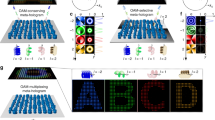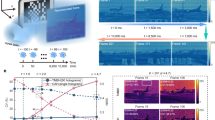Abstract
Digital optical holograms can achieve nanometre-scale resolution as a result of recent advances in metasurface technologies. This has raised hopes for applications in data encryption, data storage, information processing and displays. However, the hologram bandwidth has remained too low for any practical use. To overcome this limitation, information can be stored in the orbital angular momentum of light, as this degree of freedom has an unbounded set of orthogonal helical modes that could function as information channels. Thus far, orbital angular momentum holography has been achieved using phase-only metasurfaces, which, however, are marred by channel crosstalk. As a result, multiplex information from only four channels has been demonstrated. Here, we demonstrate an orbital angular momentum holography technology that is capable of multiplexing up to 200 independent orbital angular momentum channels. This has been achieved by designing a complex-amplitude metasurface in momentum space capable of complete and independent amplitude and phase manipulation. Information was then extracted by Fourier transform using different orbital angular momentum modes of light, allowing lensless reconstruction and holographic videos to be displayed. Our metasurface can be three-dimensionally printed in a polymer matrix on SiO2 for large-area fabrication.
This is a preview of subscription content, access via your institution
Access options
Access Nature and 54 other Nature Portfolio journals
Get Nature+, our best-value online-access subscription
$29.99 / 30 days
cancel any time
Subscribe to this journal
Receive 12 print issues and online access
$259.00 per year
only $21.58 per issue
Buy this article
- Purchase on Springer Link
- Instant access to full article PDF
Prices may be subject to local taxes which are calculated during checkout





Similar content being viewed by others
Data availability
The data that support the figures and other findings of this study are available from the corresponding authors upon reasonable request. Source data are provided with this paper.
Code availability
The code used for the meta-hologram design is available from the corresponding author upon reasonable request.
References
Downing, E., Hesselink, L., Ralston, J. & Macfarlane, R. A three-color, solid-state, three-dimensional display. Science 273, 1185–1189 (1996).
Tay, S. et al. An updatable holographic three-dimensional display. Nature 451, 694–698 (2008).
Li, J. et al. Addressable metasurfaces for dynamic holography and optical information encryption. Sci. Adv. 4, eaar6768 (2018).
Fang, X., Ren, H. & Gu, M. Orbital angular momentum holography for high-security encryption. Nat. Photonics 14, 102–108 (2020).
Heanue, J. F., Bashaw, M. C. & Hesselink, L. Volume holographic storage and retrieval of digital data. Science 265, 749–752 (1994).
Lin, X. et al. All-optical machine learning using diffractive deep neural networks. Science 361, 1004–1008 (2018).
Yu, N. et al. Light propagation with phase discontinuities: generalized laws of reflection and refraction. Science 334, 333–337 (2011).
Lin, D., Fan, P., Hasman, E. & Brongersma, M. L. Dielectric gradient metasurface optical elements. Science 345, 298–302 (2014).
Arbabi, A., Horie, Y., Bagheri, M. & Faraon, A. Dielectric metasurfaces for complete control of phase and polarization with subwavelength spatial resolution and high transmission. Nat. Nanotechnol. 10, 937–943 (2015).
Ni, X., Kildishev, A. V. & Shalaev, V. M. Metasurface holograms for visible light. Nat. Commun. 4, 2807 (2013).
Huang, L. et al. Three-dimensional optical holography using a plasmonic metasurface. Nat. Commun. 4, 2808 (2013).
Zheng, G. et al. Metasurface holograms reaching 80% efficiency. Nat. Nanotechnol. 10, 308–312 (2015).
Wang, L. et al. Grayscale transparent metasurface holograms. Optica 3, 1504–1505 (2016).
Hu, Y. et al. 3D-integrated metasurfaces for full-colour holography. Light. Sci. Appl. 8, 86 (2019).
Chen, W. T. et al. High-efficiency broadband meta-hologram with polarization-controlled dual images. Nano Lett. 14, 225–230 (2014).
Wang, H. et al. Ultrathin planar cavity metasurfaces. Small 14, 1703920 (2018).
Montelongo, Y. et al. Plasmonic nanoparticle scattering for color holograms. Proc. Natl Acad. Sci. USA 111, 12679–12683 (2014).
Wen, D. et al. Helicity multiplexed broadband metasurface holograms. Nat. Commun. 6, 8241 (2015).
Huang, Y. et al. Aluminium plasmonic multicolour meta-hologram. Nano Lett. 15, 3122–3127 (2015).
Wang, B. et al. Visible-frequency dielectric metasurfaces for multiwavelength achromatic and highly dispersive holograms. Nano Lett. 16, 5235–5240 (2016).
Kamali, S. M. et al. Angle-multiplexed metasurfaces: encoding independent wavefronts in a single metasurface under different illumination angles. Phys. Rev. X 7, 041056 (2017).
Mueller, J. P. B., Rubin, N. A., Devlin, R. C., Groever, B. & Capasso, F. Metasurface polarization optics: independent phase control of arbitrary orthogonal states of polarization. Phys. Rev. Lett. 118, 113901 (2017).
Zhao, R. et al. Multichannel vectorial holographic display and encryption. Light. Sci. Appl. 7, 95 (2018).
Wang, J. et al. Terabit free-space data transmission employing orbital angular momentum multiplexing. Nat. Photonics 6, 488–496 (2012).
Bozinovic, N. et al. Terabit-scale orbital angular momentum mode division multiplexing in fibers. Science 340, 1545–1548 (2013).
Ren, H., Li, X., Zhang, Q. & Gu, M. On-chip noninterference angular momentum multiplexing of broadband light. Science 352, 805–809 (2016).
Mair, A., Vaziri, A., Weihs, G. & Zeilinger, A. Entanglement of the orbital angular momentum states of photons. Nature 412, 313–316 (2001).
Fickler, R. et al. Quantum entanglement of high angular momenta. Science 338, 640–643 (2012).
Ren, H. et al. Metasurface orbital angular momentum holography. Nat. Commun. 10, 2986 (2019).
Lee, G. et al. Complete amplitude and phase control of light using broadband holographic metasurfaces. Nanoscale 10, 4237–4245 (2018).
Overvig, A. C. et al. Dielectric metasurfaces for complete and independent control of the optical amplitude and phase. Light. Sci. Appl. 8, 95 (2018).
Deng, Z. et al. Full-color complex-amplitude vectorial holograms based on multi-freedom metasurfaces. Adv. Funct. Mater. 30, 1910610 (2020).
Smalley, D. E., Smithwick, Q. Y. J., Bove, V. M., Barabas, J. & Jolly, S. Anisotropic leaky-mode modulator for holographic video displays. Nature 498, 313–317 (2013).
Smalley, D. E. et al. A photophoretic-trap volumetric display. Nature 553, 486–490 (2018).
Hirayama, R., Plasencia, D. M., Masuda, N. & Subramanian, S. A volumetric display for visual, tactile and audio presentation using acoustic trapping. Nature 575, 320–323 (2019).
Makey, G. et al. Breaking crosstalk limits to dynamic holography using orthogonality of high-dimensional random vectors. Nat. Photonics 13, 251–256 (2019).
Bomzon, Z., Biener, G., Kleiner, V. & Hasman, E. Space-variant Pancharatnam–Berry phase optical elements with computer-generated subwavelength gratings. Opt. Lett. 27, 1141–1143 (2002).
Saha, S. K. et al. Scalable submicrometer additive manufacturing. Science 366, 105–109 (2019).
Jin, L. et al. Noninterleaved metasurface for (26-1) spin- and wavelength-encoded holograms. Nano Lett. 18, 8016–8024 (2018).
Huang, C. et al. Ultrafast control of vortex microlasers. Science 367, 1018–1021 (2020).
Wang, B. et al. Generating optical vortex beams by momentum-space polarization vortices centred at bound states in the continuum. Nat. Photonics https://doi.org/10.1038/s41566-020-0658-1 (2020).
Zhang, Z. et al. Tunable topological charge vortex microlaser. Science 368, 760–763 (2020).
Rivenson, Y., Wu, Y. & Ozcan, A. Deep learning in holography and coherent imaging. Light. Sci. Appl. 8, 85 (2019).
Grier, D. G. A revolution in optical manipulation. Nature 424, 810–816 (2003).
Acknowledgements
H.R. acknowledges funding support through a Humboldt Research Fellowship from the Alexander von Humboldt Foundation. S.A.M. acknowledges funding support from the Deutsche Forschungsgemeinschaft and the Lee-Lucas Chair in Physics. J.R. acknowledges the Samsung Research Funding & Incubation Center for Future Technology (grant SRFC-IT1901-05) funded by Samsung Electronics, and the National Research Foundation (NRF; grants NRF-2019R1A2C3003129, CAMM-2019M3A6B3030637, NRF-2019R1A5A8080290, NRF-2018M3D1A1058997 and NRF-2015R1A5A1037668) funded by the Ministry of Science and ICT (MSIT) of the Korean government. J.J. acknowledges the Hyundai Motor Chung Mong-Koo Foundation fellowship, an NRF fellowship (NRF-2019R1A6A3A13091132) funded by the Ministry of Education of the Korean governent and the NRF-DAAD Summer Institute program funded by the NRF and German Academic Exchange Service (DAAD). X.F. acknowledges funding support from Shanghai Rising-Star Program (20QA1404100) and Zhangjiang National Innovation Demonstration Zone (ZJ2019-ZD-005).
Author information
Authors and Affiliations
Contributions
H.R. and S.A.M. proposed the idea and conceived the experiment; X.F. and H.R. calculated the complex-amplitude OAM-multiplexing holograms; J.J., J.R. and H.R. performed the numerical simulation of the 3D meta-atoms; H.R. and J.B. carried out 3D laser printing of large-scale 3D metasurfaces; H.R. and J.B. performed the optical characterization of the metasurface holograms; H.R., J.R. and S.A.M. contributed to the data analysis; all the authors contributed to the writing of the paper.
Corresponding authors
Ethics declarations
Competing interests
The authors declare no competing interests.
Additional information
Peer review information Nature Nanotechnology thanks Xianzhong Chen, Tim Wilkinson and the other, anonymous, reviewer(s) for their contribution to the peer review of this work.
Publisher’s note Springer Nature remains neutral with regard to jurisdictional claims in published maps and institutional affiliations.
Supplementary information
Supplementary Information
Supplementary Notes 1–4 and Figs. 1–18.
Supplementary Video 1
Numerical results of a holographic video display in an image plane z=z1.
Supplementary Video 2
Numerical results of a holographic video display in an image plane z=z2.
Supplementary Video 3
Experimental results of a holographic video display in an image plane z=z1.
Supplementary Video 4
Experimental results of a holographic video display in an image plane z=z2.
Source data
Source Data Fig. 2
The source data for Fig. 2b and Fig. 2d.
Source Data Fig. 4
The source data for Fig. 4.
Rights and permissions
About this article
Cite this article
Ren, H., Fang, X., Jang, J. et al. Complex-amplitude metasurface-based orbital angular momentum holography in momentum space. Nat. Nanotechnol. 15, 948–955 (2020). https://doi.org/10.1038/s41565-020-0768-4
Received:
Accepted:
Published:
Issue Date:
DOI: https://doi.org/10.1038/s41565-020-0768-4
This article is cited by
-
High-dimensional Poincaré beams generated through cascaded metasurfaces for high-security optical encryption
PhotoniX (2024)
-
Vectorial liquid-crystal holography
eLight (2024)
-
Coincidence imaging for Jones matrix with a deep-learning approach
npj Nanophotonics (2024)
-
Creating pairs of exceptional points for arbitrary polarization control: asymmetric vectorial wavefront modulation
Nature Communications (2024)
-
High-security learning-based optical encryption assisted by disordered metasurface
Nature Communications (2024)



